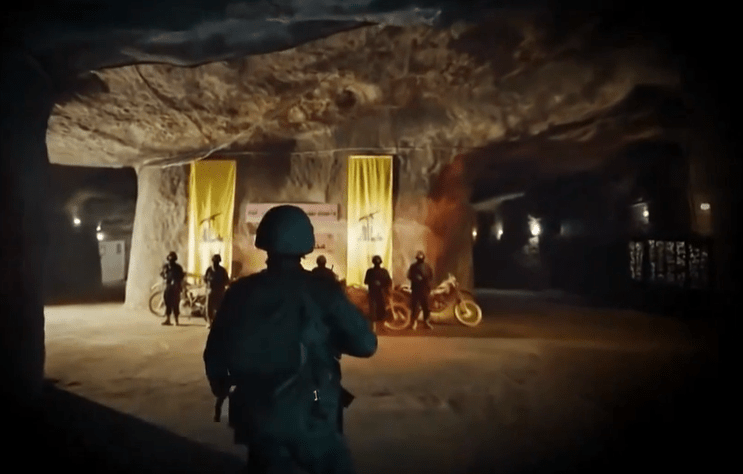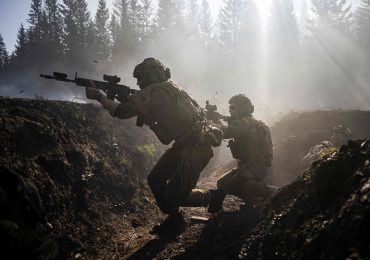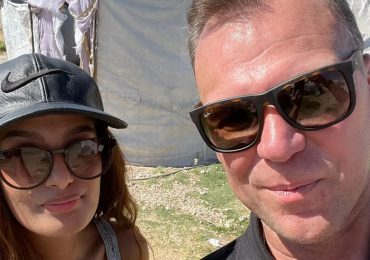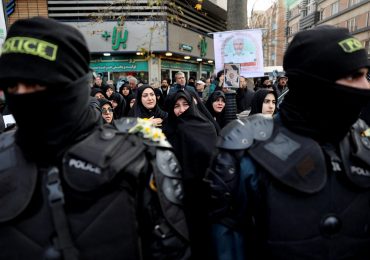HIDDEN beneath the villages and rocky hills of southern Lebanon lies Hezbollah’s terror lair – ready to lure Israeli troops into a deadly killing zone.
Gearing up for a much-awaited showdown with its southern neighbour, the Shiite terrorists have been building their labyrinth of terror tunnels for miles on end, home to a deadly arsenal of missiles.
X / @IranObserver0Hezbollah’s terrifying underground bunker chillingly awaits Israeli troops[/caption]
AFPIsraeli soldiers have been preparing to invade Lebanon[/caption]
ReutersSmoke billows over southern Lebanon on Thursday following an Israeli strike in Tyre[/caption]
Hezbollah is Iran’s biggest and best funded terror proxy group
Israel on Thursday rejected Lebanon’s ceasefire plan after the United States and France called for a 21-day halt in the brutal fighting.
Amid fears an “all-out war” could turn southern Lebanon into a “death zone”, Prime Minister Benjamin Netanyahu has vowed to double-down on Hezbollah with “full force”.
But inside the terror tunnels, Hezbollah fighters can move unseen, store weapons, and launch ambushes, creating a dangerous cat-and-mouse game with the Israeli Defense Forces (IDF).
The Iran-backed terrorists currently regarded as one of the world’s most highly armed non-state militia organisations.
Estimates place its army in the tens of thousands, and it is believed to possess about 150,000 rockets and missiles of all kinds, The Times reports.
But Hezbollah’s real objective is far more sinister.
The tunnels are designed to pull Israel’s military into a carefully constructed “fire trap,” a zone of devastation where every step forward risks disaster.
THE FIRE TRAP
At first glance, southern Lebanon appears as a patchwork of quiet villages and agricultural fields, but underneath the surface lies a chilling war zone.
Hezbollah’s tunnels are part of a larger network of bunkers, missile silos, and command centres, deeply embedded in civilian areas.
These tunnels, which can stretch for miles, link critical positions, allowing Hezbollah fighters to emerge, strike, and then vanish back underground before Israel can respond.
The strategy is simple but effective: use the tunnels to provoke and then lure Israel into the heavily fortified areas, where Hezbollah can wage guerrilla warfare on its own terms.
With thousands of fighters entrenched in these positions, Hezbollah aims to turn southern Lebanon into a battlefield where Israel’s technological and military dominance could be blunted by the challenges of underground and urban warfare.
This is what Hezbollah refers to as the “fire trap”.
As Israeli forces advance, they’re drawn deeper into unfamiliar and hostile territory.
Meanwhile, Hezbollah fighters are hidden underground, awaiting with advanced weaponry — from precision-guided missiles to lethal anti-tank rockets.
The terrorists are also quick to replace their leaders whenever they get wiped out.
On Friday, Israel killed the commander who founded and led the group’s elite Radwan force, Ibrahim Aqil.
The Israeli military chief of staff Herzi Halevi said on Sunday that Aqil’s death had shaken the organisation.
Israel says its strikes have also destroyed thousands of Hezbollah rockets and shells.
But two of the sources familiar with Hezbollah operations said the group swiftly appointed replacements for Aqil and other senior figures killed in Friday’s airstrike in Beirut’s southern suburbs.
Hezbollah leader Sayyed Hassan Nasrallah said in an Aug. 1 speech that the group quickly fills gaps whenever a leader is killed.
X / @IranObserver0The endless maze has posters of terrorists adorning its stone walls[/caption]
X / @IranObserver0A Hezbollah terrorist unloading one of their many missile-packed trucks[/caption]
X / @IranObserver0Terrorists can launch their deadly missiles straight from the bunker from hell[/caption]
X / @IranObserver0Hezbollah’s soldiers patrolling their evil base with motorbikes[/caption]
A fourth source, a Hezbollah official, said the attack on communication devices put 1,500 fighters out of commission because of their injuries, with many having been blinded or had their hands blown off.
While that is a major blow, it represents a fraction of Hezbollah’s strength, which a report for the US Congress on Friday put at 40,000-50,000 fighters.
Nasrallah has said the group has 100,000 fighters.
Since October, when Hezbollah began firing at Israel in October in support of its ally Hamas in Gaza, it has redeployed fighters to frontline areas in the south, including some from Syria, the three sources said.
It has also been bringing rockets into Lebanon at a fast pace, anticipating a drawn-out conflict, the sources said, adding that the group sought to avoid all out war.
A DECADE OF PREPARATION
Hezbollah’s tunnel-building project is not a recent development.
Following the 2006 Lebanon War, in which Israel and Hezbollah fought to a bloody standstill, the group began preparing for the next conflict, constructing a vast underground network across southern Lebanon.
The lessons of that war, in which Hezbollah’s small, mobile units were able to surprise and sometimes overpower Israeli forces, have been embedded in its military doctrine ever since.
The tunnels are now a key part of this strategy, allowing Hezbollah to replicate the tactics of insurgencies around the world: strike fast, disappear, and use the enemy’s size and strength against them.
Some of these tunnels have been found stretching into Israeli territory, designed to facilitate surprise raids deep inside northern Israel.
In 2018, the IDF launched Operation Northern Shield, a months-long mission to detect and destroy Hezbollah’s cross-border tunnels.
ReutersIsraeli Army tanks are transported, amid cross-border hostilities between Hezbollah and Israel, in northern Israel, on Thursday[/caption]
RexIDF troops conducting a military operation in Gaza Strip[/caption]
A picture taken in 2020 shows part of a 200-metre-long tunnel that Hezbollah fighters built over three years to combat Israeli forcesAFP
The discovery of these tunnels — some reinforced with concrete and running dozens of meters underground — revealed just how advanced Hezbollah’s capabilities had become.
Last month, Hezbollah revealed its hidden terror tunnel network from which missiles can be launched in a chilling threat to Israel.
A blood-curdling video released by the Lebanese terrorists revealed a giant underground roads with enough room for lorries to transport their deadly weapons.
Posters of leaders and soldiers adorn the tall stone walls as heavily armed men speed through the “missile city” in motorbikes.
Trucks loaded with enormous missiles make their way through the dark roads in a frightening glimpse of the terrorists’ arsenal.
Drone footage then shows the seemingly endless terror maze, which also appears to be home to military tech and computers.
UNDERGROUND WARFARE
For Israel, Hezbollah’s tunnel network represents a dangerous challenge, forcing the IDF to rethink its military strategies.
While Israel’s air force and intelligence operations are among the most advanced in the world, tunnels represent a different kind of threat: one that is hard to detect and even harder to destroy.
In a ground war, Israel’s forces would likely be confronted by guerrilla fighters emerging from these tunnels, hitting targets with precision, then disappearing before an effective counterattack.
The tunnels allow Hezbollah to use the terrain to its advantage, turning the rocky, rugged landscape of southern Lebanon into a labyrinthine defence system.
Israeli soldiers, even with advanced technology, could find themselves navigating a battlefield designed to ensnare them at every turn.
The IDF has responded with new tunnel detection technology, specialised training for subterranean warfare, and preemptive strikes on Hezbollah’s infrastructure.
But even with these efforts, the sheer scale and sophistication of Hezbollah’s underground network could mean that any future conflict will involve fighting in some of the most difficult conditions imaginable — from narrow, booby-trapped tunnels to urban combat zones, where civilians often serve as human shields.
Israel’s Iron Dome air defence system in action on August 3 shooting down rockets fired from Hezbollah in Lebanon
Leave a comment







